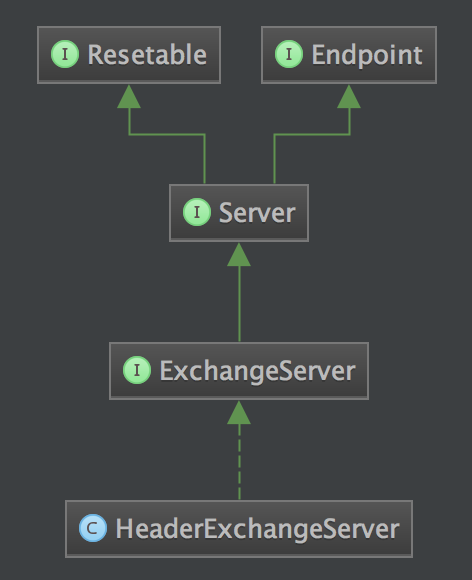1
2
3
4
5
6
7
8
9
10
11
12
13
14
15
16
17
18
19
20
21
22
23
24
25
26
27
28
29
30
31
32
33
34
35
36
37
38
39
40
41
42
43
44
45
46
47
48
49
50
51
52
53
54
55
56
57
58
59
60
61
62
63
64
65
66
67
68
69
70
71
72
73
74
75
76
77
78
79
80
81
82
83
84
85
86
87
88
89
90
91
92
93
94
95
96
97
98
99
100
101
102
103
104
105
106
107
108
109
110
111
112
113
114
115
116
117
118
119
120
121
122
123
124
125
126
127
128
129
130
131
132
133
134
135
136
137
138
139
140
141
142
143
144
145
146
147
148
149
150
151
152
153
154
155
156
157
158
| public Object decode(Channel channel, ChannelBuffer buffer) throws IOException {
int readable = buffer.readableBytes();
byte[] header = new byte[Math.min(readable, HEADER_LENGTH)];
buffer.readBytes(header);
return decode(channel, buffer, readable, header);
}
protected Object decode(Channel channel, ChannelBuffer buffer, int readable, byte[] header) throws IOException {
if (readable > 0 && header[0] != MAGIC_HIGH
|| readable > 1 && header[1] != MAGIC_LOW) {
int length = header.length;
if (header.length < readable) {
header = Bytes.copyOf(header, readable);
buffer.readBytes(header, length, readable - length);
}
for (int i = 1; i < header.length - 1; i++) {
if (header[i] == MAGIC_HIGH && header[i + 1] == MAGIC_LOW) {
buffer.readerIndex(buffer.readerIndex() - header.length + i);
header = Bytes.copyOf(header, i);
break;
}
}
return super.decode(channel, buffer, readable, header);
}
if (readable < HEADER_LENGTH) {
return DecodeResult.NEED_MORE_INPUT;
}
int len = Bytes.bytes2int(header, 12);
checkPayload(channel, len);
int tt = len + HEADER_LENGTH;
if (readable < tt) {
return DecodeResult.NEED_MORE_INPUT;
}
ChannelBufferInputStream is = new ChannelBufferInputStream(buffer, len);
try {
return decodeBody(channel, is, header);
} finally {
if (is.available() > 0) {
try {
if (logger.isWarnEnabled()) {
logger.warn("Skip input stream " + is.available());
}
StreamUtils.skipUnusedStream(is);
} catch (IOException e) {
logger.warn(e.getMessage(), e);
}
}
}
}
protected Object decodeBody(Channel channel, InputStream is, byte[] header) throws IOException {
byte flag = header[2], proto = (byte) (flag & SERIALIZATION_MASK);
Serialization s = CodecSupport.getSerialization(channel.getUrl(), proto);
long id = Bytes.bytes2long(header, 4);
if ((flag & FLAG_REQUEST) == 0) {
Response res = new Response(id);
if ((flag & FLAG_EVENT) != 0) {
res.setEvent(Response.HEARTBEAT_EVENT);
}
byte status = header[3];
res.setStatus(status);
if (status == Response.OK) {
try {
Object data;
if (res.isHeartbeat()) {
data = decodeHeartbeatData(channel, deserialize(s, channel.getUrl(), is));
} else if (res.isEvent()) {
data = decodeEventData(channel, deserialize(s, channel.getUrl(), is));
} else {
DecodeableRpcResult result;
if (channel.getUrl().getParameter(
Constants.DECODE_IN_IO_THREAD_KEY,
Constants.DEFAULT_DECODE_IN_IO_THREAD)) {
result = new DecodeableRpcResult(channel, res, is,
(Invocation) getRequestData(id), proto);
result.decode();
} else {
result = new DecodeableRpcResult(channel, res,
new UnsafeByteArrayInputStream(readMessageData(is)),
(Invocation) getRequestData(id), proto);
}
data = result;
}
res.setResult(data);
} catch (Throwable t) {
if (log.isWarnEnabled()) {
log.warn("Decode response failed: " + t.getMessage(), t);
}
res.setStatus(Response.CLIENT_ERROR);
res.setErrorMessage(StringUtils.toString(t));
}
} else {
res.setErrorMessage(deserialize(s, channel.getUrl(), is).readUTF());
}
return res;
} else {
Request req = new Request(id);
req.setVersion("2.0.0");
req.setTwoWay((flag & FLAG_TWOWAY) != 0);
if ((flag & FLAG_EVENT) != 0) {
req.setEvent(Request.HEARTBEAT_EVENT);
}
try {
Object data;
if (req.isHeartbeat()) {
data = decodeHeartbeatData(channel, deserialize(s, channel.getUrl(), is));
} else if (req.isEvent()) {
data = decodeEventData(channel, deserialize(s, channel.getUrl(), is));
} else {
DecodeableRpcInvocation inv;
if (channel.getUrl().getParameter(
Constants.DECODE_IN_IO_THREAD_KEY,
Constants.DEFAULT_DECODE_IN_IO_THREAD)) {
inv = new DecodeableRpcInvocation(channel, req, is, proto);
inv.decode();
} else {
inv = new DecodeableRpcInvocation(channel, req,
new UnsafeByteArrayInputStream(readMessageData(is)), proto);
}
data = inv;
}
req.setData(data);
} catch (Throwable t) {
if (log.isWarnEnabled()) {
log.warn("Decode request failed: " + t.getMessage(), t);
}
req.setBroken(true);
req.setData(t);
}
return req;
}
}
|


